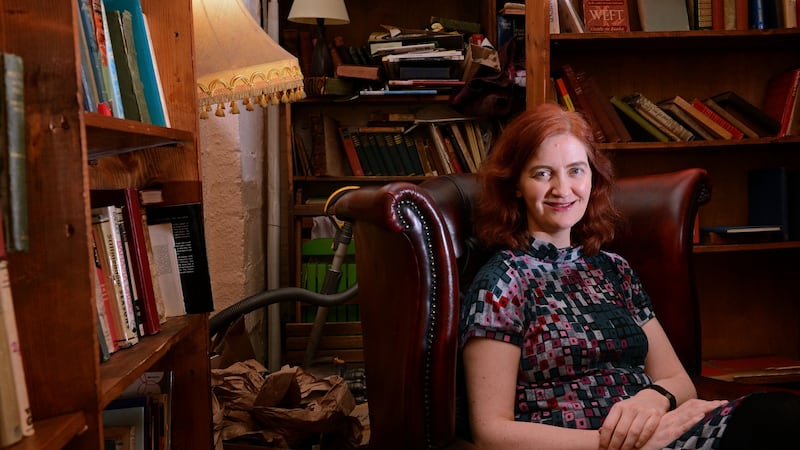On March 1st of this year I awoke in the very early hours of the morning with the sense that the ambient light outside my darkened apartment had changed. When I looked out the window I saw some very familiar sights: the surface of the physical world had turned completely white, and snow was being driven by wind through cones of lamplight.
Had I been at home in rural Ontario, I would have sighed and gone back to bed. But I was not in Ontario, I was in Dublin, and I was looking forward to greeting some authors – Emma Donoghue, Victoria Glendinning and Margaret Atwood to be precise – at Dublin Airport later in the morning. The reason they were coming was to help me celebrate literary connections between Ireland and Canada at a small festival that I as the Craig Dobbin Chair in the College of Arts and Humanities, Paul Halferty as head of Canadian Studies, and a dedicated team of UCD personnel had been madly preparing during the previous six months.
It was as if the biggest Irish writer of them all, Archangel Joyce, disapproved of this unlikely mating of minds between Ireland and Canada, and had staged a spectacular intervention from wherever he resides in the afterlife, ensuring that “snow was general all over Ireland”. Or as Halferty put it later in the day when we knew for sure that everything would have to be cancelled, “we tried to bring Canadian literature to Ireland, but ended up bringing only Canadian weather”.

But what is this mating of minds between the Irish and the Canadians all about? Perhaps, if indeed Archangel Joyce were to have taken offence at the fuss being made concerning something so small, he would not have been entirely wrong.

When I was a child in the 1950s and 1960s, Canada was an odd place. We sang God Save the Queen every morning in our classrooms, and during art period we drew and coloured pictures of the Union Jack. (Not so easy, by the way: try it sometime.) We had only been Canadian citizens, after all, since the Act of Canadian Citizenship in 1946: before that we were defined as "British subjects resident in Canada". In spite of this colonial mentality, we were beginning, now and then, to experience confusion concerning our family allegiances. Should we continue to look east toward the figure of Mother England? Or, now that predominantly American television networks existed in our lives, should we look south toward the big daddy figure of the USA? Like all children of divorced parents, we wavered back and forth, drawn to the one who seemed to be the most glamorous, on the one hand, or who had most power on the other.
And then there were the Irish. Who knew that so many Irish genes danced in our blood? By the time of Canadian Confederation in 1867, the Irish were the second largest ethnic group in the new Dominion (formerly known as British North America) and comprised 24 per cent of the population. Many of us, however, including those of us who were of Irish descent, knew little about these historic numbers by the 1950s.
Migrant ships
The Orange Order still dominated Canadian life and Canadian politics, and the little crumbs of official Canadian history taught in our schools made no reference to the presence of Irish Catholics in our midst. The one exception to this was the brief, and much propagandised skirmishes of the Fenian raids in 1866. Fenians, and by extension Irish Catholics on both sides of the border, were depicted as terrorists bent on destroying Mother England. After their ill-organised uprisings had been quashed, and the street violence that sometimes attended both Orange and St Patrick’s Day parades settled down, most things Irish were conveniently forgotten in Canada.
Still it is fair to say that since European contact Canada has always been, and continues to be, one of the homes imagined by the Irish when they set out from these shores to start a new life. In the 1840s the number of Irish migrants arriving in British North America was simply staggering. It is said that in the year 1847, at the height of the Great Famine, there were so many Irish immigrants arriving in the St Lawrence River that the barely moving migrant ships stretched over a dozen miles downstream from the quarantine station at Grosse Isle. Many migrants were dying. More than 5,000 are buried in the cemetery at the quarantine station on the isle. Thousands more are buried in mass graves in or near towns and cities on the banks of the St Lawrence and the shores of the Great Lakes where fever sheds were plentiful. The migrants who survived these horrors fanned out over what would soon be known as Upper and Lower Canada, and were the great-great grandparents of Canadians like myself, who are of Irish descent and who were born into a much easier and safer world.

In spite of our lack of formal education on the subject, Canadian families of Irish descent never forgot Ireland, and because they did not forget, Ireland became an imagined sacred homeland for us, and – in some ways – set the tone for the future. Since the great Irish migration of the 19th century, immigrants from dozens of different backgrounds have repeated the experience of the Irish and have come to Canada. It seems fair to say that in Canada everyone has two homelands in their imagination; the one where they settled, and the abandoned, mourned homeland that they were forced to leave behind. The indigenous people of Canada are in mourning as well for a lost home: the land and the life they knew before settler contact changed that land and that life forever.
Thomas D’Arcy Magee
The first Irish-Canadian literary voice heard on Canadian soil was that of Carlingford-born politician, historian, poet and orator Thomas D’Arcy Magee. A great sentimentalist when it came to writing and publishing earnest poetry about the history and the plight of the land of his birth, and a legendary speaker, Magee is best remembered by Canadians as the victim (in 1868) of our only political assassination. This assassination, like everything related to Magee, was Irish in its make-up, and was a response, some believed, to the fact that after spending most of his life arguing for Irish independence, Magee was deemed by extremists to be a turncoat when he adopted the British parliamentary system in Canada. Patrick Whelan, a young “Fenian” who was discovered to be a member of the St Patrick’s Literary Society, was apprehended and hanged for the crime. Whelan always denied his guilt, even writing to Queen Victoria to protest the unfairness of his conviction.
By the time I began the research connected to my third novel Away, which partly dealt with how my Quinn ancestors had emigrated to Canada in the mid 19th century, even a story as colourful as Magee's had been largely forgotten. I was delighted by the fact that most archival files concerning Irish settler life had remained unviolated since their deposition over a century before, but I was also disturbed that such a large part of Canada's history had remained hidden for so long.
However, well hidden as the physical evidence may be, the stories continue to be told. Families, like my own, pass them down from generation to generation. Children listen and the notion of the “old country” is lit in the imagination. The feeling of loss – of landscape and tribe – is never fully forgotten. And the Famine Irish themselves are still fully present among us in Canada. Red-haired, French-speaking children in Quebec are visible reminders of the kindness of the Quebecois when it came to adopting the orphans of the great migration’s ship fever. Canadian folk songs follow the patterns of Irish jigs and reels. One small island in the Saint Lawrence River is criss-crossed by perfectly constructed 19th-century Irish drystone walls.

And Irish characters sometimes walk through the pages of Canadian novels. Some of them – as in Margaret Atwood's Alias Grace, and in my own novels – are altered by their life in Canada. Others, like Anna O'Donnell in Irish-Canadian author Emma Donoghue's brilliant novel The Wonder, live in Ireland and seemingly have nothing to do with Canada at all, except for the important fact that the book in which their narrative unfolds was written in that country. Now and then an Irish voice finds expression on Canadian ground, or a great Canadian diplomat develops an intense literary and romantic relationship with a famous Irish writer, as in the case of Charles Ritchie and Elizabeth Bowen. As D'Arcy Magee said in one of his last addresses to parliament in Ottawa, "Miracles would cease to be miracles if they were events of everyday occurrence; the very nature of wonders requires that they should be rare."
In the spirit of literary exploration of the term “home,” as it relates to Canadian/Irish literary connections, Jane Urquhart, The Craig Dobbin Chair of Canadian Studies at University College Dublin, and the greater University College Dublin community have once again invited an exciting cast of Irish and Canadian writers, including Margaret Atwood, Anne Enright, Frank McGuinness, and John Banville, to join them at UCD at an event entitled Imagining Home: Literary Connections Between Canada and Ireland. This event will be held at O’Reilly Hall UCD, at 7.30pm for one evening only, June 6th, with appearances by Margaret Atwood, Anne Enright, and John Banville.











